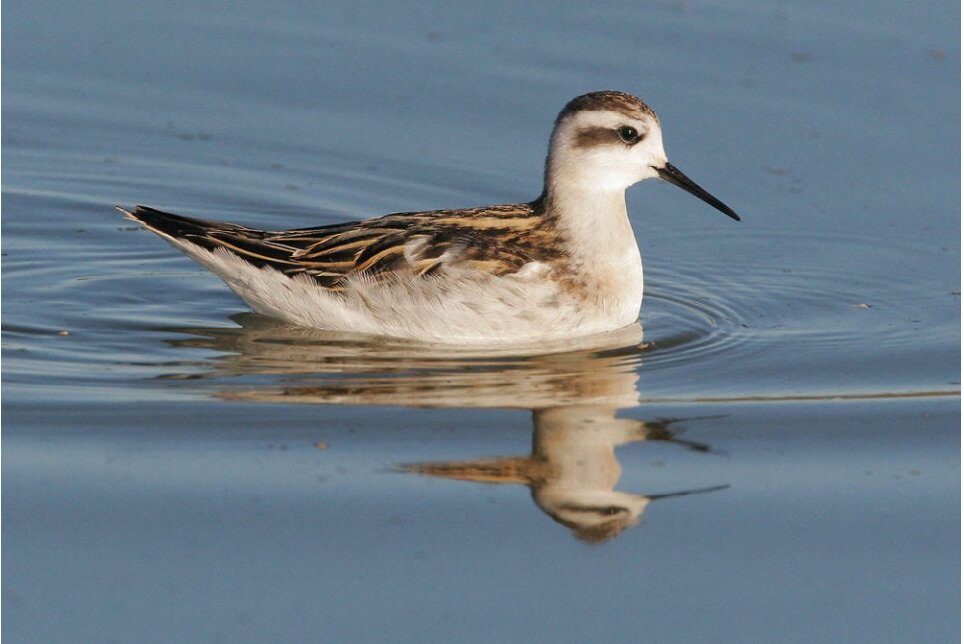What to Look for Now—Timely Birding
August & September 2019
Matthew Dodder
SCVAS Executive Director
Willow Flycatcher by Tom Grey
If there’s anything we can learn from birding, it’s that every time of year provides an opportunity for discovery. From the too-short, cold-and-wet days of winter, to the blazing heat of midsummer, and its 9 o’clock sunsets...when you step outside, you’re going to see something wonderful.
The August-September window shows many post-breeding birds on the move. Willow Flycatchers are often found during this time as are our southbound Hammond’s Flycatchers. There is a bump in Yellow Warbler numbers, and some rarer species like Nashville and MacGillivray’s Warblers show up on occasion. The checklist shows many uncommon and rare land bird species appearing now.
Juvenile Short-billed Dowitcher by Tom Grey
For me though, September has always been a good time to watch a variety of Shorebird species pass through our area, or settle in for the winter. Many common birds like Least and Western Sandpipers have already reappeared, and one can pick out the colorful juveniles among them by their fresh, neatly arranged back feathers. That difference helps us with other species IDs as well. The headache we often experience as we struggle with Dowitchers briefly subsides when we discover that young Short- billed Dowitchers are much easier to pick out when we look for their internally-patterned, or tiger-striped tertials and more vibrant colors.
Both Red-necked and Wilson’s Phalaropes, which began to show up in numbers along the bay last month, may linger into September, but they will look very different now than they did in spring. At that time they were all dressed up for the party on their northern breeding grounds, but now they will be acquiring their winter drabs. But the immatures, once again, will stand out because of delicate gold or reddish highlights. We also get a second opportunity to notice their subtle structural differences which allow the two Phalaropes to be identified from quite far away. (Wilson’s has a longer neck and bill).
Juvenile Red-necked Phalarope by Tom Grey
And so it goes for many other Shorebirds of late summer—the end of the breeding season, the mass movement south, the subduing of adult colors, and the spectacle of youth. It’s all on display now.
Juvenile Baird’s Sandpiper by Tom Grey
Among the rarer Shorebirds to look for now are Baird’s and Pectoral Sandpipers. Both are long distance migrants making their way from the high arctic toward South America. They generally pass through our area between August to September, and often they are the younger birds. Their GISS (general impression of size and shape) as well as markings make them especially fun to search for among the flocks near the bay. (Baird’s has very long primaries that extend well beyond the tail and cross over each other over the rump). Semipalmated Sandpiper might be out there too, hiding somewhere in a large group of Peeps, but only the discerning eye can pick out their different shape and posture. (Semipalmated Sandpiper has a short, blunt bill and even front-to-rear balance). Stilt Sandpiper has occasionally chosen this time of year to make its rare appearances in our county. Similarly, the bulk of our Ruff sightings occur in September and often continue through the winter, usually in Alviso. (Ruffs often appear small-headed, thick necked, and heavy bellied). Solitary Sandpiper is rare in our county, but tends to appear in September as it makes its way southward often along creeks or small ponds. (Look for the dark rump and underwings of Solitary Sandpipers). All of these make exciting targets for the late summer birder.
There are many good places to watch the Shorebird spectacle. A few of the best are the Palo Alto Baylands lagoon, Charleston Slough at the end of Terminal Boulevard in Mountain View, the New Chicago Marsh (EEC) in Alviso, the salt ponds north of the Alviso Marina, and the Gilroy Water Treatment Ponds. Conveniently, SCVAS will be leading several trips to these locations in the weeks and months ahead. For a full description of these outings, be sure to visit our field trip page. Also, you can sign up for email alerts here for changes and additions to our trip schedule.
In fact, there are just as many places to go birding as there are things to look for now. Whether you use this season to locate one of the rarer Shorebirds making its way south, or find new joy in the common species returning to our area, August and September truly is the best time to go birding!
Juvenile Pectoral Sandpiper (left) beside juvenile Least Sandpiper by Tom Grey






